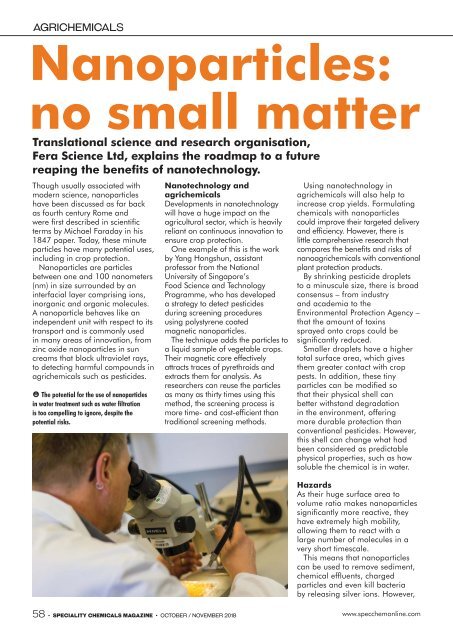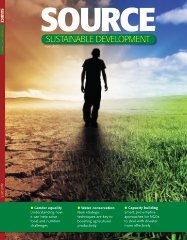Speciality Chemicals Magazine October_November 2018
Speciality Chemicals Magazine is the number one and longest published global magazine dedicated exclusively to the fine and speciality chemicals industries. Our unrivalled reputation for comprehensive coverage and perspective on the global chemical industry makes the magazine essential reading for everyone involved in this market. Speciality Chemicals Magazine has the best established global industry specific print and digital circulation with over 52,000 targeted individuals and distribution to shows and events worldwide. These are personalised subscribers who have requested to be sent a copy of the magazine. This circulation has been built up over 37 years of publishing and has been cleared to European Data Protection Standards (EDPS) 2018. In addition to this personalised circulation, selected articles and industry news are posted on our website, social media sites and in your bi-weekly newsletter.
Speciality Chemicals Magazine is the number one and longest published global magazine dedicated exclusively to the
fine and speciality chemicals industries. Our unrivalled reputation for comprehensive coverage and perspective on the global
chemical industry makes the magazine essential reading for everyone involved in this market.
Speciality Chemicals Magazine has the best established global industry specific print and digital circulation with over
52,000 targeted individuals and distribution to shows and events worldwide. These are personalised subscribers who have requested to be sent a copy of the magazine.
This circulation has been built up over 37 years of publishing and has been cleared to European Data Protection Standards (EDPS) 2018.
In addition to this personalised circulation, selected articles and industry news are posted on our website,
social media sites and in your bi-weekly newsletter.
Create successful ePaper yourself
Turn your PDF publications into a flip-book with our unique Google optimized e-Paper software.
Nanoparticles:<br />
no small matter<br />
Translational science and research organisation,<br />
Fera Science Ltd, explains the roadmap to a future<br />
reaping the benefits of nanotechnology.<br />
Though usually associated with<br />
modern science, nanoparticles<br />
have been discussed as far back<br />
as fourth century Rome and<br />
were first described in scientific<br />
terms by Michael Faraday in his<br />
1847 paper. Today, these minute<br />
particles have many potential uses,<br />
including in crop protection.<br />
Nanoparticles are particles<br />
between one and 100 nanometers<br />
(nm) in size surrounded by an<br />
interfacial layer comprising ions,<br />
inorganic and organic molecules.<br />
A nanoparticle behaves like an<br />
independent unit with respect to its<br />
transport and is commonly used<br />
in many areas of innovation, from<br />
zinc oxide nanoparticles in sun<br />
creams that block ultraviolet rays,<br />
to detecting harmful compounds in<br />
agrichemicals such as pesticides.<br />
S The potential for the use of nanoparticles<br />
in water treatment such as water filtration<br />
is too compelling to ignore, despite the<br />
potential risks.<br />
Nanotechnology and<br />
agrichemicals<br />
Developments in nanotechnology<br />
will have a huge impact on the<br />
agricultural sector, which is heavily<br />
reliant on continuous innovation to<br />
ensure crop protection.<br />
One example of this is the work<br />
by Yang Hongshun, assistant<br />
professor from the National<br />
University of Singapore’s<br />
Food Science and Technology<br />
Programme, who has developed<br />
a strategy to detect pesticides<br />
during screening procedures<br />
using polystyrene coated<br />
magnetic nanoparticles.<br />
The technique adds the particles to<br />
a liquid sample of vegetable crops.<br />
Their magnetic core effectively<br />
attracts traces of pyrethroids and<br />
extracts them for analysis. As<br />
researchers can reuse the particles<br />
as many as thirty times using this<br />
method, the screening process is<br />
more time- and cost-efficient than<br />
traditional screening methods.<br />
Using nanotechnology in<br />
agrichemicals will also help to<br />
increase crop yields. Formulating<br />
chemicals with nanoparticles<br />
could improve their targeted delivery<br />
and efficiency. However, there is<br />
little comprehensive research that<br />
compares the benefits and risks of<br />
nanoagrichemicals with conventional<br />
plant protection products.<br />
By shrinking pesticide droplets<br />
to a minuscule size, there is broad<br />
consensus – from industry<br />
and academia to the<br />
Environmental Protection Agency –<br />
that the amount of toxins<br />
sprayed onto crops could be<br />
significantly reduced.<br />
Smaller droplets have a higher<br />
total surface area, which gives<br />
them greater contact with crop<br />
pests. In addition, these tiny<br />
particles can be modified so<br />
that their physical shell can<br />
better withstand degradation<br />
in the environment, offering<br />
more durable protection than<br />
conventional pesticides. However,<br />
this shell can change what had<br />
been considered as predictable<br />
physical properties, such as how<br />
soluble the chemical is in water.<br />
Hazards<br />
As their huge surface area to<br />
volume ratio makes nanoparticles<br />
significantly more reactive, they<br />
have extremely high mobility,<br />
allowing them to react with a<br />
large number of molecules in a<br />
very short timescale.<br />
This means that nanoparticles<br />
can be used to remove sediment,<br />
chemical effluents, charged<br />
particles and even kill bacteria<br />
by releasing silver ions. However,<br />
<br />
www.specchemonline.com
















